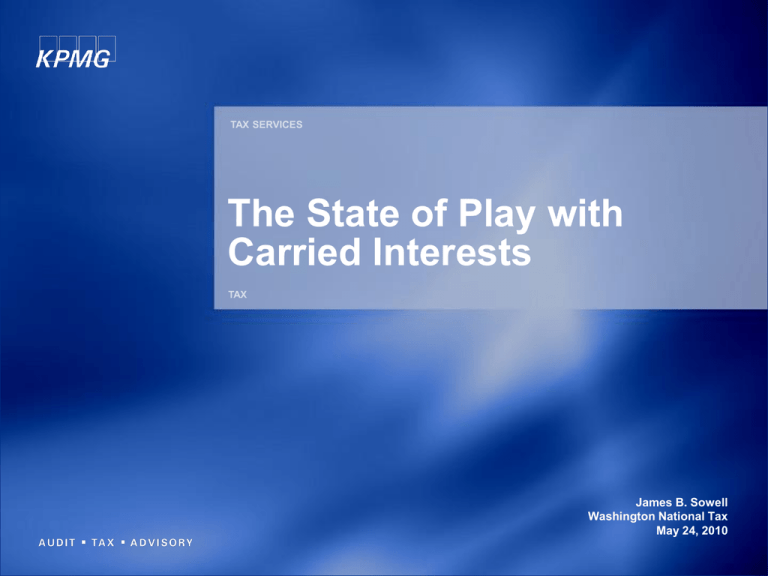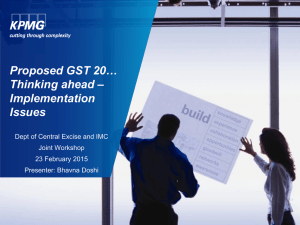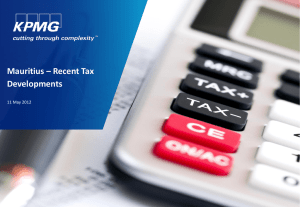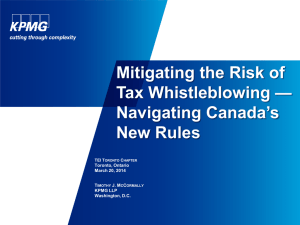
TAX SERVICES
The State of Play with
Carried Interests
TAX
James B. Sowell
Washington National Tax
May 24, 2010
ANY TAX ADVICE IN THIS COMMUNICATION IS NOT
INTENDED OR WRITTEN BY KPMG TO BE USED, AND
CANNOT BE USED, BY A CLIENT OR ANY OTHER
PERSON OR ENTITY FOR THE PURPOSE OF (i)
AVOIDING PENALTIES THAT MAY BE IMPOSED ON
ANY TAXPAYER OR (ii) PROMOTING, MARKETING OR
RECOMMENDING TO ANOTHER PARTY ANY
MATTERS ADDRESSED HEREIN.
You (and your employees, representatives, or agents) may disclose to any and all persons, without limitation, the tax
treatment or tax structure, or both, of any transaction described in the associated materials we provide to you,
including, but not limited to, any tax opinions, memoranda, or other tax analyses contained in those materials.
The information contained herein is general in nature and based on authorities that are subject to change.
Applicability to specific situations is to be determined through consultation with your tax adviser.
© 2010 KPMG LLP, a U.S. limited liability partnership and a member firm of the KPMG network of independent member firms affiliated with KPMG International, a Swiss cooperative. All rights reserved.
FOR INTERNAL USE ONLY.
2
Carried Interests
In 2007, Representative Sander Levin introduced bill to address carried interests
Later in 2007, House of Representatives passed the “Temporary Tax Relief Act of
2007,” which included provision on carried interests
Similar provision passed House of Representatives in “Alternative Minimum Tax
Relief Act of 2008”
On April 2, 2009, Representative Levin introduced bill revising technical aspects of
House legislation
On May 11, 2009, Administration budget describes provision to tax carried
interests
On September 8, 2009, Joint Committee on Taxation released its Description of
President’s Budget Proposals
On December 9, 2009, House of Representatives passed “Tax Extenders Act of
2009,” which included carried interest provision (the “2009 House Bill”)
On February 1, 2010, Administration budget again describes carried interest
provision
On May 20, 2010, amendments to the Senate’s extenders bill were introduced in
the House of Representatives under the title the “American Jobs and Closing Tax
Loopholes Act of 2010” (the “House Bill”); amendments include revisions to the
carried interest provisions included in 2009 House Bill
© 2010 KPMG LLP, a U.S. limited liability partnership and a member firm of the KPMG network of independent member firms affiliated with KPMG International, a Swiss cooperative. All rights reserved.
FOR INTERNAL USE ONLY.
3
Carried Interests
House Bill would provide that, for purposes of section
83, where a partnership interest is transferred in
connection with the performance of services provided
for (or on behalf of) the partnership
Liquidation value would be treated as the FMV of the
partnership interest; and
The person receiving the partnership interest would be
treated as making a section 83(b) election unless the
person affirmatively elects not to have section 83(b)
apply (i.e., section 83(b) election is the default rule; no
protective election required).
© 2010 KPMG LLP, a U.S. limited liability partnership and a member firm of the KPMG network of independent member firms affiliated with KPMG International, a Swiss cooperative. All rights reserved.
FOR INTERNAL USE ONLY.
4
Carried Interests
Who is covered by section 710 of the House Bill?
Holders of an “investment services partnership interest” (“ISPI”)
An ISPI is a partnership interest held (directly or indirectly) by a
person if it was reasonably expected (at the time that such person
acquired such interest) that such person (or any person related to
such person) would provide (directly or indirectly) a substantial
quantity of any of the following services with respect to assets
held (directly or indirectly) by the partnership :
advising the partnership as to the advisability of investing in, purchasing, or
selling a specified asset (i.e., securities, real estate held for rental or
investment, partnership interests, commodities, or options or derivative
contracts with respect to these assets);
managing, acquiring, or disposing of any specified asset;
arranging financing with respect to acquiring specified assets; or
any activity in support of any of the previously described activities.
© 2010 KPMG LLP, a U.S. limited liability partnership and a member firm of the KPMG network of independent member firms affiliated with KPMG International, a Swiss cooperative. All rights reserved.
FOR INTERNAL USE ONLY.
5
Carried Interests
Service Partners
Mgmt
Co
Mgmt
Services
LPs
GP
FUND
Investment
Assets
GP entity is “related” to party providing investment services (Mgmt Co.), so GP’s interest in Fund is an
ISPI . (“Related” is by reference to section 267 or 707(b).)
Service Partners are “indirectly” (through Mgmt Co.) providing services with respect to investment
assets that are held “indirectly” (through Fund) by the GP entity, so Service Partners’ interests in GP
entity are ISPIs
© 2010 KPMG LLP, a U.S. limited liability partnership and a member firm of the KPMG network of independent member firms affiliated with KPMG International, a Swiss cooperative. All rights reserved.
FOR INTERNAL USE ONLY.
6
Carried Interests
Who is covered by the House Bill?
Although the statute generally applies by reference to a
person’s anticipated services at the time the partnership
interest is received, if a person who did not anticipate
providing investment management services at the time
the partnership interest is received subsequently begins
to provide investment management services with
respect to specified assets of the partnership, that
person’s partnership interest can become an ISPI as of
the time of such change.
The qualified capital of such person immediately after the change in
services is treated as not less than the fair market value of the interest.
Unclear how the “allocation rule”(discussed on slide 28) applies by
reference to this qualified capital interest
© 2010 KPMG LLP, a U.S. limited liability partnership and a member firm of the KPMG network of independent member firms affiliated with KPMG International, a Swiss cooperative. All rights reserved.
FOR INTERNAL USE ONLY.
7
Carried Interests
What is the potential impact of the House Bill for a
party who holds a carried interest?
Net income and net loss with respect to an ISPI
generally is treated as ordinary.
Net losses are allowed only to the extent that aggregate
net income for prior years exceeds aggregate net
losses for such years. (Prior years include only years
for which section 710 is in effect.) To the extent not
utilized, the losses carry over to the following year.
Basis in partnership interest is not adjusted
downward where loss is not allowed for a given year.
© 2010 KPMG LLP, a U.S. limited liability partnership and a member firm of the KPMG network of independent member firms affiliated with KPMG International, a Swiss cooperative. All rights reserved.
FOR INTERNAL USE ONLY.
8
Carried Interests
What is the potential impact of the House Bill for a
party who holds a carried interest?
A blended rate applies with respect to individual partners
The general rule relating to classification as ordinary income
applies only with respect to the “applicable percentage” of such
income
For taxable years beginning prior to January 1, 2013, the “applicable
percentage” is 50%
For subsequent taxable years, the “applicable percentage” is 75%
The rule relating to loss deferral applies only by reference to the
“applicable percentage” of the net loss for the taxable year
Blended rate applies only to individuals, so presumably will not
permit REIT to pay any capital gain dividend attributable to income
related to ISPI that is not a qualified capital interest
© 2010 KPMG LLP, a U.S. limited liability partnership and a member firm of the KPMG network of independent member firms affiliated with KPMG International, a Swiss cooperative. All rights reserved.
FOR INTERNAL USE ONLY.
9
Carried Interests
What is the potential impact of the House Bill for a
party who holds a carried interest?
Example: Individual partner is allocated, with respect to an ISPI,
$100X ordinary income and $100x LTCG for the taxable year
ending December 31, 2011
50% of income is reclassified under the ISPI rules
Accordingly, $50x of ordinary income and $50x of LTCG would not
be reclassified
The other $50x of ordinary income and $50x of LTCG would be
reclassified as all ordinary income attributable to an ISPI
© 2010 KPMG LLP, a U.S. limited liability partnership and a member firm of the KPMG network of independent member firms affiliated with KPMG International, a Swiss cooperative. All rights reserved.
FOR INTERNAL USE ONLY.
10
Carried Interests
What is the potential impact under the House Bill for a party who
disposes of a carried interest?
Gain from the disposition of an ISPI is treated as ordinary income
(or blended ordinary/capital based upon applicable percentage for
individuals). Loss from the disposition of such an interest is an
ordinary loss (or blended) to the extent that prior post-enactment
net income attributable to such interest exceeds prior net loss.
Deferred losses do not reduce the basis of the partnership interest, so
that deferred losses will, in effect, be recognized on the disposition of
the interest. However, the losses would be capital rather than
ordinary.
Exception for individual partner in PTP if neither the partner nor a
family member provided investment management services with respect
to specified assets held by the PTP (although section 751 reference in
section 710(b)(5) is not turned off for these purposes )
© 2010 KPMG LLP, a U.S. limited liability partnership and a member firm of the KPMG network of independent member firms affiliated with KPMG International, a Swiss cooperative. All rights reserved.
FOR INTERNAL USE ONLY.
11
Carried Interests
What is the potential impact under the House Bill for a party who
disposes of a carried interest?
Provision generally overrides non-recognition rules for gain
transactions
Exception for contributions of an ISPI to another partnership
where taxpayer elects to treat partnership interest received as
an ISPI and agrees to comply with applicable reporting and
recordkeeping requirements
For individuals, gain is recognized only to the extent that gain is
treated as ordinary income by reference to applicable
percentage
© 2010 KPMG LLP, a U.S. limited liability partnership and a member firm of the KPMG network of independent member firms affiliated with KPMG International, a Swiss cooperative. All rights reserved.
FOR INTERNAL USE ONLY.
12
Carried Interests
Sponsor
RE1
RE2
REIT
RE3
Some Partnership
Interests Contributed
UPREIT
Sponsor of Real Estate projects (together with a portion of the LPs) transfers interests in
partnerships to UPREIT partnership in exchange for UPREIT partnership interests
Transfer of ISPI to another partnership is subject to nonrecognition so long as transferor
properly elects and follows reporting and recordkeeping requirements
© 2010 KPMG LLP, a U.S. limited liability partnership and a member firm of the KPMG network of independent member firms affiliated with KPMG International, a Swiss cooperative. All rights reserved.
FOR INTERNAL USE ONLY.
13
Carried Interests
Sponsor
RE1
RE2
RE3
Some Partnership
Interests Contributed
Corp
Sponsor of Real Estate projects (together with a portion of the LPs) transfers interests in
partnerships to corporation
Transfer of ISPI to a corporation triggers recognition of gain to the extent that will be
treated as ordinary income attributable to an ISPI (i.e., applicable percentage relevant for
an individual)
© 2010 KPMG LLP, a U.S. limited liability partnership and a member firm of the KPMG network of independent member firms affiliated with KPMG International, a Swiss cooperative. All rights reserved.
FOR INTERNAL USE ONLY.
14
Carried Interests
What is the potential impact of being subject to the House Bill for
a party who receives a distribution of property with respect to an
ISPI?
If the partnership distributes appreciated property with respect to an
ISPI
Gain will be triggered to the partnership as if it sold the property for its
fair market value and that gain will be allocated to the distributee as
ordinary income (or blended ordinary/capital based upon applicable
percentage for individuals)
The property is treated as cash with respect to the distributee partner,
so that gain will be triggered to the extent that the value of the
distributed property exceeds the partner’s basis in the partnership
interest (determined after adjustment for gain allocated)
Distributee partner takes fair market value basis in distributed property
© 2010 KPMG LLP, a U.S. limited liability partnership and a member firm of the KPMG network of independent member firms affiliated with KPMG International, a Swiss cooperative. All rights reserved.
FOR INTERNAL USE ONLY.
15
Carried Interests
What is the potential impact of being subject to the House Bill for
a party who receives a distribution of property with respect to an
ISPI?
If a partner receives a distribution with respect to an ISPI in
connection with a partnership merger, division, or termination
(under section 708(b)(1)(B)), the provisions discussed on the prior
slide will not apply if the partner makes an election to treat the
partnership interest received as an ISPI and agrees to comply with
applicable reporting and recordkeeping requirements.
© 2010 KPMG LLP, a U.S. limited liability partnership and a member firm of the KPMG network of independent member firms affiliated with KPMG International, a Swiss cooperative. All rights reserved.
FOR INTERNAL USE ONLY.
16
Carried Interests
Sponsor
RE1
RE2
REIT
RE3
Partnerships Merge
Assets Over or Up
UPREIT
Sponsor of Real Estate projects, together with LPs, accomplish partnership mergers through assetover or assets-up form
Both merger forms involve liquidation of RE partnerships (distribution of UPREIT units in assets-over or
RE assets in assets-up)
Liquidation of RE Partnerships will not trigger recognition results under “distribution” rule if make
election and agree to comply with reporting and recordkeeping requirements
© 2010 KPMG LLP, a U.S. limited liability partnership and a member firm of the KPMG network of independent member firms affiliated with KPMG International, a Swiss cooperative. All rights reserved.
FOR INTERNAL USE ONLY.
17
Carried Interests
Is ordinary income treatment the only thing to worry
about?
No. Where an individual is engaged in the trade or business of
providing the specified investment services, income taken into
account as ordinary under the House Bill (by reference to the
“applicable percentage”) would become subject to self-employment
tax regardless of whether the partner is a limited partner and
regardless of whether the underlying partnership income would be
exempt from the self-employment tax (i.e., dividends, interest,
capital gain, etc).
Also need to be cognizant of possible impact relating to deferred
compensation rules, such as sections 409A and 457A.
© 2010 KPMG LLP, a U.S. limited liability partnership and a member firm of the KPMG network of independent member firms affiliated with KPMG International, a Swiss cooperative. All rights reserved.
FOR INTERNAL USE ONLY.
18
Carried Interests
What provision is made for service providers who also
invest capital?
The House Bill exempts from its coverage the portion of
a service provider’s partnership interest that is acquired
for invested capital.
This requires that the partnership interest be acquired
on account of invested capital and that allocations of
distributive share to the service partner satisfy certain
requirements.
Exemption relates both to ordinary income treatment
and loss deferral.
© 2010 KPMG LLP, a U.S. limited liability partnership and a member firm of the KPMG network of independent member firms affiliated with KPMG International, a Swiss cooperative. All rights reserved.
FOR INTERNAL USE ONLY.
19
Carried Interests
What provision is made for service providers who also invest
capital?
A “qualified capital interest” means the portion of a partner’s
interest in the capital of the partnership that is attributable to
The FMV of money or property contributed to the partnership (but not
“deemed” contributions under section 752(a))
Amounts included under section 83 with respect to transfer of interest
The excess of
Items of income and gain taken into account under section 702 with respect
to the partnership interest, over
Items of deduction or loss so taken into account.
Reduced by
Distributions to the partner, and
Losses allocated in excess of income
© 2010 KPMG LLP, a U.S. limited liability partnership and a member firm of the KPMG network of independent member firms affiliated with KPMG International, a Swiss cooperative. All rights reserved.
FOR INTERNAL USE ONLY.
20
Carried Interests
Service Partner
$1 million
50% until 10% IRR
Then 60%
LP
$1 million
50% until 10% IRR
Then 40%
FUND
RE Assets
Partnership was formed on January 1, 2006, and each partner contributed $1 million on
that date
As of May 31, 2010, each partner has been allocated $1.0 million of net income, and has
received $1.4 million in distributions
Hypothetically assume June 1, 2010 effective date for legislation
Each partner is considered to have a $600,000 qualified capital interest
If partnership had made $2 million debt-financed distribution to each partner based upon
a refinancing and distribution of unrealized asset appreciation, it appears that the Service
Partner would have no qualified capital; Concern that Service Partner can earn no non-ISPI
return even though he still is receiving a portion of his return by reference to that of the LP
© 2010 KPMG LLP, a U.S. limited liability partnership and a member firm of the KPMG network of independent member firms affiliated with KPMG International, a Swiss cooperative. All rights reserved.
FOR INTERNAL USE ONLY.
21
Carried Interests
Service Partners
Bank
Mgmt
Co
Mgmt
Services
LPs
GP
FUND
Investment
Assets
GP Entity borrows to make capital contribution to Fund on behalf of Service Partners
Service Partners receive no credit for deemed contributions to GP entity under section
752(a)
© 2010 KPMG LLP, a U.S. limited liability partnership and a member firm of the KPMG network of independent member firms affiliated with KPMG International, a Swiss cooperative. All rights reserved.
FOR INTERNAL USE ONLY.
22
Carried Interests
Service Partners
Mgmt
Co
Mgmt
Services
LPs
GP
FUND
Investment
Assets
GP entity serves as GP in all historic Funds
GP uses cash from carried interests in pre-effective date Funds for contribution to post-effective date Fund
Service Partners now would appear to get credit in GP for pre-effective date undistributed income and thus, in
many situations, would have qualified capital in that entity
What if cash distributed to GP entity by existing Fund and contributed to new Fund does not match
income allocated to GP entity by existing Fund? (See slides 34 and 35 regarding “allocation rule”)
Under 2009 House Bill, Service Partners got no qualified capital for undistributed income
© 2010 KPMG LLP, a U.S. limited liability partnership and a member firm of the KPMG network of independent member firms affiliated with KPMG International, a Swiss cooperative. All rights reserved.
FOR INTERNAL USE ONLY.
23
Carried Interests
What provision is made for service providers who also invest
capital?
Regulatory authority is provided to address situations where the fair
market value of property contributed to a partnership differs from
the adjusted basis of such property
Without some rule, there could be double-counting of qualified capital where
property with section 704(c) built-in gain is contributed by the service partner
(i.e., by providing credit for fair market value of contributed property and taxable
income subsequently recognized that is attributable to appreciation at the time
of contribution)
Presumably, the section 704(c) gain should be treated as attributable to the qualified
capital interest, although the statute does not address this point
© 2010 KPMG LLP, a U.S. limited liability partnership and a member firm of the KPMG network of independent member firms affiliated with KPMG International, a Swiss cooperative. All rights reserved.
FOR INTERNAL USE ONLY.
24
Carried Interests
What provision is made for service providers who also
invest capital?
A partner providing services will not be treated as
having a qualified capital interest to the extent that
contributed capital is attributable to a loan or other
advance made or guaranteed, directly or indirectly, by
any other partner or the partnership (or a person related
to such partner or the partnership).
For purposes of measuring the proportionate qualified
capital interest of a service partner, any loan or other
advance to the partnership by a non-service partner will
be treated as a qualified capital interest.
© 2010 KPMG LLP, a U.S. limited liability partnership and a member firm of the KPMG network of independent member firms affiliated with KPMG International, a Swiss cooperative. All rights reserved.
FOR INTERNAL USE ONLY.
25
Carried Interests
Employees
Loan
Guarantee
$
Bank
CoInvest
GP
Fund
$
Mgmt
Services
Pship
RE Assets
Employees invest capital in partnership promoted by Sponsor/GP
Employees provide 1/3 of capital and borrow the remaining 2/3 on a recourse basis
Sponsor/GP guarantees debt of employees
Employees do not get credit for borrowed capital as “qualified capital”
© 2010 KPMG LLP, a U.S. limited liability partnership and a member firm of the KPMG network of independent member firms affiliated with KPMG International, a Swiss cooperative. All rights reserved.
FOR INTERNAL USE ONLY.
26
Carried Interests
What provision is made for service providers who also invest
capital?
A qualified capital interest is defined by reference to the “interest,”
which seemingly permits qualified capital to carry over in a transfer
of an interest.
The JCT Report accompanying the 2009 House Bill provided that a
transferee of an ISPI “in a fully taxable transaction” will succeed to the
qualified capital account of the transferor partner.
In the context of such a purchase, the qualified capital interest is not
measured by reference to the purchase price of the interest.
Particularly a problem upon purchase of interest from another service
provider who has no historic qualified capital
© 2010 KPMG LLP, a U.S. limited liability partnership and a member firm of the KPMG network of independent member firms affiliated with KPMG International, a Swiss cooperative. All rights reserved.
FOR INTERNAL USE ONLY.
27
Carried Interests
What provision is made for service providers who also
invest capital?
The “allocation rule” provides that allocations with respect to a
qualified capital interest will not be subject to recharacterization and
loss deferral if
Allocations are made to the qualified capital interest in the same
manner as such allocations are made to other qualified capital
interests held by partners who do not provide investment management
services to the partnership (and who are not related to the partner
holding the qualified capital interest); and
Allocations made to the non-service partners are significant compared
to the allocations made to the qualified capital interests of the service
partners.
© 2010 KPMG LLP, a U.S. limited liability partnership and a member firm of the KPMG network of independent member firms affiliated with KPMG International, a Swiss cooperative. All rights reserved.
FOR INTERNAL USE ONLY.
28
Carried Interests
Service Partner
LPs
$1 million
$1 million
FUND
RE Assets
First, 100% to LPs until 10% IRR
Next,100% to Service Partner until 12%
IRR
Finally, 60% to Service Partner and
40% to LPs
Service Partner agrees to subordinate its return on contributed capital to that of
the LPs, but will receives a higher proportionate return on its capital, assuming
success of venture, to compensate for taking additional risk with respect to its
return
The Service Partner does not have a “benchmark,” as it is not receiving the
same return as a non-service provider in the partnership
The allocation rule is not satisfied, so it appears that no portion of the return on
the Service Partner’s qualified capital is permitted
© 2010 KPMG LLP, a U.S. limited liability partnership and a member firm of the KPMG network of independent member firms affiliated with KPMG International, a Swiss cooperative. All rights reserved.
FOR INTERNAL USE ONLY.
29
Carried Interests
Service Partner
$1 million
50% until 10% IRR
Then 60%
LPs
$1 million
50% until 10% IRR
Then 40%
FUND
RE Assets
Service Partner agrees to bear first losses and LPs absorb losses only after
Service Partner’s capital is fully depleted
Allocation of losses to Service Partner are not made in same manner as losses
made to non-service providing LPs, so that allocation rule is not satisfied
Losses attributable to Service Partner’s qualified capital would appear to be
deferred until income is allocated to Service Partner or interest is sold or liquidated
Service Partner’s losses do not become usable once LPs are allocated losses
Can income allocations still qualify in this circumstance?
© 2010 KPMG LLP, a U.S. limited liability partnership and a member firm of the KPMG network of independent member firms affiliated with KPMG International, a Swiss cooperative. All rights reserved.
FOR INTERNAL USE ONLY.
30
Carried Interests
What provision is made for service providers who also
invest capital?
Treasury has authority to provide guidance in certain
situations
Describing a permissible return where no or insignificant allocations
are made to non-service providers
Describing how the allocation rule may be applied separately with
respect to a portion of a qualified capital interest
Providing that allocations will not be treated as failing to satisfy the
allocation rule merely because the allocations to the qualified capital
interest represent a lower return than the allocations made to other
qualified capital interests
© 2010 KPMG LLP, a U.S. limited liability partnership and a member firm of the KPMG network of independent member firms affiliated with KPMG International, a Swiss cooperative. All rights reserved.
FOR INTERNAL USE ONLY.
31
Carried Interests
Developer Partner 1
Developer Partner 2
$1 million
50%
$1 million
50%
Development
Pship
RE Assets
Each partner contributes equal capital, performs equivalent services, and receives an
equivalent return
There are no non-service providers, so must look to regulations for permissible return
JCT Report accompanying the 2009 House Bill anticipates that, where there are no nonservice providers, regs would allow service partner to earn a return in proportion to capital
Should there be a different return allowed for Developer Partners if they admitted a
capital/non-service partner?
© 2010 KPMG LLP, a U.S. limited liability partnership and a member firm of the KPMG network of independent member firms affiliated with KPMG International, a Swiss cooperative. All rights reserved.
FOR INTERNAL USE ONLY.
32
Carried Interests
Service Partner
$1 million
50% until 10% IRR
Then 60%
LPs
$1 million
50% until 10% IRR
Then 40%
FUND
RE Assets
Service Partner and LPs each have been allocated income to match full accrued 10% IRR amount and
receive an allocation of $1 million gain pursuant to the 60%-40% sharing ratio – cash from gain
transaction is retained by the partnership
Service Partner receives credit for qualified capital attributable to disproportionate income allocation –
this causes the overall return on the Service Partner’s proportionately larger qualified capital interest to
differ from LPs
Regulatory authority is provided to permit (1) isolation of return to qualified capital other than the
disproportionate undistributed income and (2) the Service Partner to receive a lower return on its qualified
capital
It appears that no increased return is permitted with respect to increased qualified capital interest, as
there is no benchmark return for that qualified capital
© 2010 KPMG LLP, a U.S. limited liability partnership and a member firm of the KPMG network of independent member firms affiliated with KPMG International, a Swiss cooperative. All rights reserved.
FOR INTERNAL USE ONLY.
33
Carried Interests
What provision is made for service providers who also
invest capital?
Except as provided in regulations, in the case of tiered
partnerships, all allocations made with respect to a qualified
capital interest in a lower-tier partnership which meet the
requirements of the allocation rule will be treated as
satisfying the allocation rule at the upper-tier partnership
level to the extent allocated on the basis of qualified capital
interests in the upper-tier partnership
© 2010 KPMG LLP, a U.S. limited liability partnership and a member firm of the KPMG network of independent member firms affiliated with KPMG International, a Swiss cooperative. All rights reserved.
FOR INTERNAL USE ONLY.
34
Carried Interests
Service Partners
Mgmt
Co
Mgmt
Services
LPs
GP
FUND
Investment
Assets
Note that all partners in GP are service providers
Based upon the tiered-partnership rule, the House Bill now would appear to allow Service Partners in
GP to determine permissible return by reference to non-service providing LPs in Fund
What if Service Partners’ aggregate qualified capital in GP entity differs from GP entity’s qualified
capital interest in Fund? (See slide 23)
© 2010 KPMG LLP, a U.S. limited liability partnership and a member firm of the KPMG network of independent member firms affiliated with KPMG International, a Swiss cooperative. All rights reserved.
FOR INTERNAL USE ONLY.
35
Carried Interests
Service Partners
Bank
Mgmt
Co
Mgmt
Services
LPs
GP
FUND
Investment
Assets
Tiered partnership rule does not provide relief in this situation (discussed earlier) because
Service Partners do not have qualified capital interest in GP entity (since no credit for
section 752(a) deemed contributions).
© 2010 KPMG LLP, a U.S. limited liability partnership and a member firm of the KPMG network of independent member firms affiliated with KPMG International, a Swiss cooperative. All rights reserved.
FOR INTERNAL USE ONLY.
36
Carried Interests
What provision is made for service providers who also
invest capital?
Except as provided in regulations, the allocation rule will not
be violated merely because the allocations made to a
qualified capital interest do not reflect the cost of investment
management services provided (directly or indirectly) to the
partnership by the holder of such interest (or a related
person)
Appears aimed at permitting service partner to satisfy the allocation rule even
though the return on such partner’s qualified capital does not bear management
fees or the cost of the carried interest borne by non-service partners
What if a portion of the costs is attributable to services other than investment
management services? Will this rule still provide relief?
© 2010 KPMG LLP, a U.S. limited liability partnership and a member firm of the KPMG network of independent member firms affiliated with KPMG International, a Swiss cooperative. All rights reserved.
FOR INTERNAL USE ONLY.
37
Carried Interests
Service Partner
LPs
$5 million
$95 million
FUND
RE Assets
Allocation provisions state that allocations are made, preliminarily, based on percentage interests
(95% LPs/5% Service Partner)
After the preliminary allocation, amounts allocated to each LP then are re-allocated, with such
amounts being allocated solely to the LP until such partner has earned a 10% IRR on contributed
capital, and the residual is allocated 80% to the LP and 20% to the Service Partner
The expense for the management fee is allocated solely to the LPs
The only difference between an LP and the Service Provider is that the return of the Service Provider
does not reflect self-charged amounts
Allocation rule appears to be satisfied, but impact is not clear (i.e., is full return permitted or only the
portion equal to the amount earned by the LPs)
© 2010 KPMG LLP, a U.S. limited liability partnership and a member firm of the KPMG network of independent member firms affiliated with KPMG International, a Swiss cooperative. All rights reserved.
FOR INTERNAL USE ONLY.
38
Carried Interests
What provision is made for service providers who also
invest capital?
Special rule is provided for dispositions of ISPI where a
portion of such interest is a qualified capital interest
The rule that provides for ordinary (or blended for individuals)
treatment of gain or loss on disposition of an ISPI will not apply
to so much of such gain or loss as bears the same proportion to
the entire amount of such gain or loss as
The distributive share of gain or loss that would have been
allocated to the qualified capital interest if the partnership had sold
all of its assets for fair market value, bears to
The distributive share of gain or loss that would have been so
allocated to the ISPI of which such qualified capital interest is a
part.
© 2010 KPMG LLP, a U.S. limited liability partnership and a member firm of the KPMG network of independent member firms affiliated with KPMG International, a Swiss cooperative. All rights reserved.
FOR INTERNAL USE ONLY.
39
Carried Interests
What provision is made for service providers who also
invest capital?
Not clear how rules treat distributions with respect to a qualified
capital interest. Disposition rule technically applies by virtue of
cross-reference to section 710(b) (which includes distribution rule),
but the mechanics of rule seem to operate only by reference to
dispositions.
Do you apply exclusion of asset gain at partnership level by reference
to proportion measured based upon disposition of all assets?
If so, in determining gain based upon fair market value of distributed
property over adjusted basis in partnership interest, how does qualified
capital exception operate?
Or do you trigger all gain under section 710(b)(6), and allocate
distributive share between ISPI and qualified capital as part of
allocable share of partnership income?
© 2010 KPMG LLP, a U.S. limited liability partnership and a member firm of the KPMG network of independent member firms affiliated with KPMG International, a Swiss cooperative. All rights reserved.
FOR INTERNAL USE ONLY.
40
Carried Interests
Service Partner
LP
$1 million
50% interest
$1 million
50% interest
FUND
RE Assets
Service Partner and LP contribute proportionate capital and divide all income and loss 50/50
The interest held by the Service Partner is an ISPI, because the Service Partner provides
services in managing the real estate held for rental. However, the Service Partner is
compensated entirely through a management fee for those services.
Although the Service Partner’s entire interest in the Fund is a qualified capital interest that is
allocated income on a permissible basis, any distribution of property to the Service Partner may
trigger all gain with respect to that property (which would be allocated to the Service Partner,
with a portion possibly attributable to qualified capital), and any additional gain by reference to
the fair market value of the distributed property over the Service Partner’s basis in its Fund
interest would be triggered as well
© 2010 KPMG LLP, a U.S. limited liability partnership and a member firm of the KPMG network of independent member firms affiliated with KPMG International, a Swiss cooperative. All rights reserved.
FOR INTERNAL USE ONLY.
41
Carried Interests
What are some of the other potential effects of the
legislation?
REITs continue to apply 1.856-3(g) to carried interest for purposes
of analyzing income and asset tests. Income received by a REIT
pursuant to an investment services partnership interest, however,
will be ordinary income, as it is for other taxpayers.
Legislation also makes favorable provision for carried interests held by
UPREIT partnership in determining qualifying income.
Starting 10 years after the date of enactment, the legislation would
cause ordinary income allocated with respect to an ISPI to be nonqualifying income for purposes of the PTP 90% income test
Exception for income earned by certain PTPs that invest primarily in other PTPs
and income from mineral and natural resource activities.
© 2010 KPMG LLP, a U.S. limited liability partnership and a member firm of the KPMG network of independent member firms affiliated with KPMG International, a Swiss cooperative. All rights reserved.
FOR INTERNAL USE ONLY.
42
Carried Interests
The House Bill also would apply ordinary income treatment to
income with respect to “disqualified interests” received by a party
providing “investment management services,” where the value of
such interests substantially relates to the income or gain from
assets under management.
“Disqualified interests” are:
Any interest in an entity other than indebtedness;
Convertible or contingent debt of such entity;
Option or other right to acquire property described above; and
Any derivative instrument entered into (directly or indirectly) with
such entity or any investor in such entity.
But a “disqualified interest” does not include a partnership
interest, stock of a taxable corporation (except as provided in
regs), or stock of an S corporation (except as provided in regs)
© 2010 KPMG LLP, a U.S. limited liability partnership and a member firm of the KPMG network of independent member firms affiliated with KPMG International, a Swiss cooperative. All rights reserved.
FOR INTERNAL USE ONLY.
43
Carried Interests
For purposes of the “disqualified interest” rule, a
“taxable corporation” is:
A domestic C corporation; or
A foreign corporation if substantially all of corporation’s
income is (1) effectively connected with a US trade or
business or (2) subject to a comprehensive foreign
income tax.
Regulatory authority is provided to further prevent
avoidance of the purposes of the rules relating to
carried interests
© 2010 KPMG LLP, a U.S. limited liability partnership and a member firm of the KPMG network of independent member firms affiliated with KPMG International, a Swiss cooperative. All rights reserved.
FOR INTERNAL USE ONLY.
44
Carried Interests
Section 6662 would be amended to provide a 40%
penalty where a person had an underpayment as a
result of being treated as holding a “disqualified
interest” or violating anti-abuse regs.
The penalty would not apply if
Relevant facts affecting tax treatment of the item are adequately
disclosed;
There is or was substantial authority for such treatment; and
Taxpayer reasonably believed that such treatment was more
likely than not proper.
© 2010 KPMG LLP, a U.S. limited liability partnership and a member firm of the KPMG network of independent member firms affiliated with KPMG International, a Swiss cooperative. All rights reserved.
FOR INTERNAL USE ONLY.
45
Carried Interests
Broad regulatory authority to carry out the purposes of
section 710, including
Providing modifications to the application of the section
to the extent consistent with the purposes of the section;
Preventing avoidance of the purposes of the section;
and
Coordinating the section with other provisions of the
Code.
© 2010 KPMG LLP, a U.S. limited liability partnership and a member firm of the KPMG network of independent member firms affiliated with KPMG International, a Swiss cooperative. All rights reserved.
FOR INTERNAL USE ONLY.
46
Carried Interests
Effective date under House Bill generally would apply
to “taxable years ending after the date of enactment”
In the case of a partnership taxable year that includes the date of
enactment, the amount of income covered by the legislation is
equal to the lesser of
The net income for the entire partnership taxable year, or
Net income determined by only taking into account items
attributable to the portion of the partnership taxable year which
is after the date of enactment
Applies to dispositions and distributions after the date of
enactment.
Waiver for estimated tax penalty to the extent underpayment is
created or increased by legislation.
© 2010 KPMG LLP, a U.S. limited liability partnership and a member firm of the KPMG network of independent member firms affiliated with KPMG International, a Swiss cooperative. All rights reserved.
FOR INTERNAL USE ONLY.
47
Presenter’s contact details
James B. Sowell
KPMG LLP
202 533 5710
jsowell@kpmg.com
© 2010 KPMG LLP, a U.S. limited liability partnership and a member firm of the KPMG network of independent member firms affiliated with KPMG International, a Swiss cooperative. All rights reserved.
FOR INTERNAL USE ONLY.










